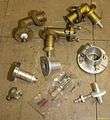EIA RF Connectors
EIA RF Connectors are used to connect two items of high power radio frequency rigid or semi-rigid (flexline) coaxial transmission line. Typically these are only required in very high power transmitting installations (10s of kW to MW) where the feedline diameters may be several inches. One side of the connection is denoted as a male connection, or bullet, while the other side is denoted as the female connection, or cup. The EIA under the Electronic Components Industry Association (http://www.ecianow.org/), are responsible for a number of standard imperial connector sizes.
Dimensions
The flange design, inner and outer conductor dimensions are standardized, by EIA, in the RS-225, 50 Ω (ohm), and RS-259, 75 Ω, standards. They are commonly referred to by the outer diameter of the outer conductor in fractional inches. Sizes covered under these two standards range from 3/8 to 6 1/8 inch outside diameter (OD) for 50 Ω and 3/8 to 3 1/8 inch OD for 75 Ω. Peak pulse power handling, driven by voltage breakdown, is more or less frequency independent for any given size (and can be deduced by assuming ~300 V RMS per mm of inner to outer spacing), but the average power, limited by losses heating the centre conductors, increases approximately with the square root of the operating frequency. Commonly the limit is quoted as that dissipation that will raise the inner temperature to 100 °C when the outer is maintained constant at +40 °C. Field failures can occur at power levels well below this if the central bullet connections are not making uniform positive contact and free of contamination. Conversely the average power ratings can be significantly exceeded if there is forced air flow either through the inner conductor or through the void between the inner and outer conductors. Many years ago, the two RS standards were considered obsolete by EIA. Only recently (until 2007) there has been an effort by manufacturers in the US to update these standards.
International standards
The corresponding International standards are published by the International Electrotechnical Commission: IEC 60339-1[1] and IEC 60339-2.[2] These standards are more complete as they include many additional sizes that are missing in the EIA standards.
Interchangeability
Many of these sizes are also interchangeable with RF Connectors defined by the US military in MIL-DTL-24044.[3][4]
Gallery
-

EIA flange connectors and adaptor to N socket
-

EIA flange connectors in use on Band II combiner
-

EIA flange connectors in use on a diplexer
-

Collection of EIA Flange connectors, adaptor, bullets etc
Manufacturers
- Exir Broadcasting
- Radio Frequency Systems
- Alan Dick
- Andrew
- Shively Labs
- JACAL conectores coaxil
- Myat Industries
- Electronics Research
- SPINNER GmbH
- SIRA srl
- SILEX SYSTEM TELECOM
References
- ↑ "IEC 60339-1:1971 General purpose rigid coaxial transmission lines and their associated flange connectors - Part 1: General requirements and measuring methods" (PDF). International Electrotechnical Commission.
- ↑ "IEC 60339-2:1996 General purpose rigid coaxial transmission lines and their associated flange connectors - Part 2: Detail specifications" (PDF). International Electrotechnical Commission.
- ↑ "DLA Land and Maritime MilSpecs & Drawings". Landandmaritime.dla.mil. Retrieved 2012-06-01.
- ↑ Defense Standardization Program Office. "Search - Results - Document Details". assistdocs.com. Retrieved 2012-06-01.